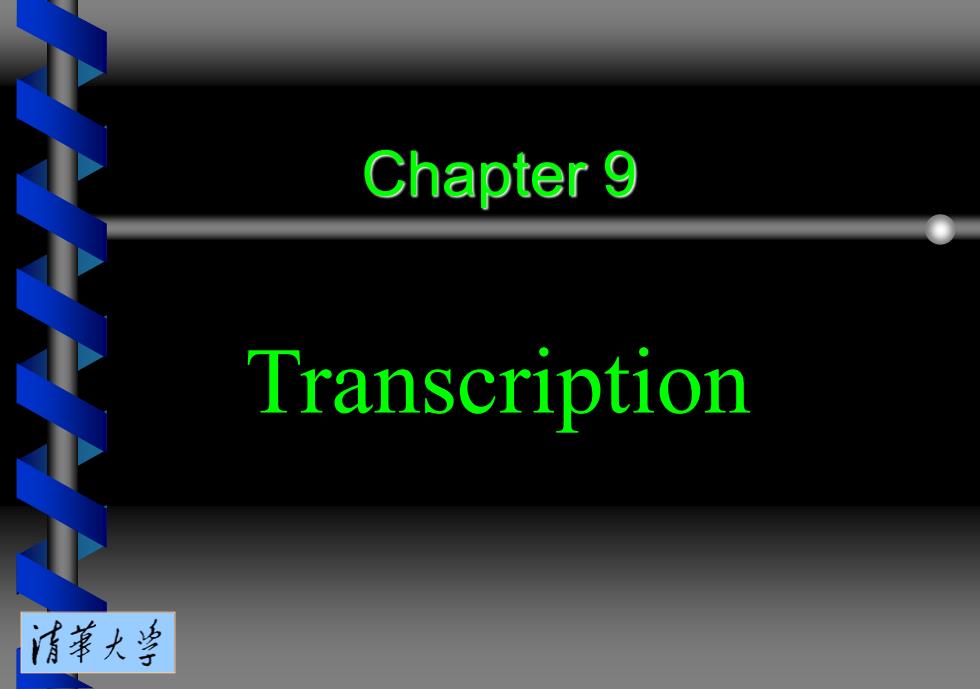
Chapter 9 Transcription 清革大当
Chapter 9 Transcription
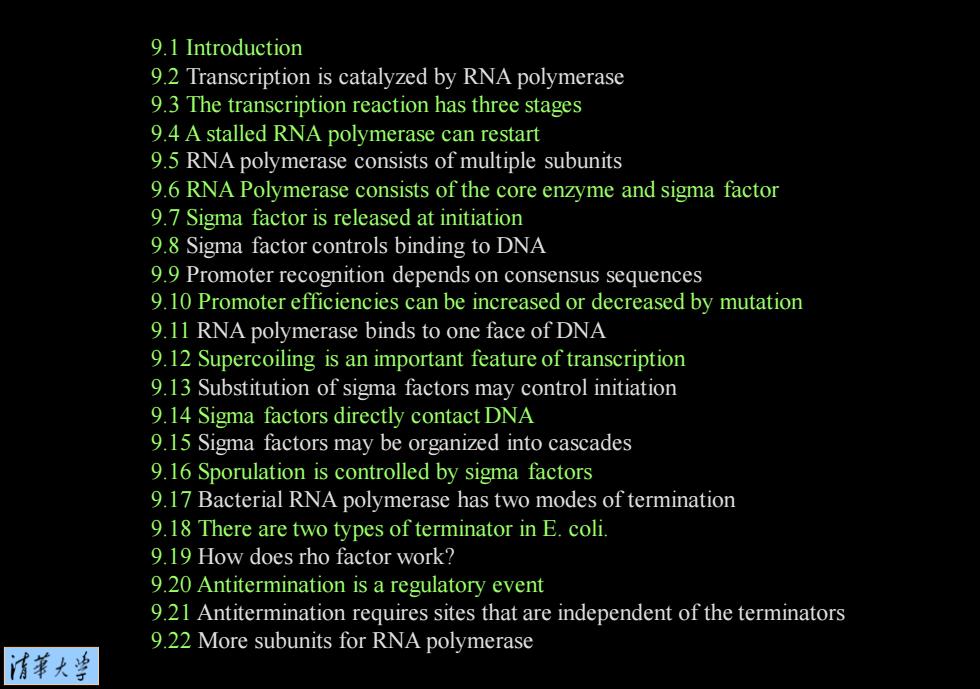
9.1 Introduction 9.2 Transcription is catalyzed by RNA polymerase 9.3 The transcription reaction has three stages 9.4 A stalled RNA polymerase can restart 9.5 RNA polymerase consists of multiple subunits 9.6 RNA Polymerase consists of the core enzyme and sigma factor 9.7 Sigma factor is released at initiation 9.8 Sigma factor controls binding to DNA 9.9 Promoter recognition depends on consensus sequences 9.10 Promoter efficiencies can be increased or decreased by mutation 9.11 RNA polymerase binds to one face of DNA 9.12 Supercoiling is an important feature of transcription 9.13 Substitution of sigma factors may control initiation 9.14 Sigma factors directly contact DNA 9.15 Sigma factors may be organized into cascades 9.16 Sporulation is controlled by sigma factors 9.17 Bacterial RNA polymerase has two modes of termination 9.18 There are two types of terminator in E.coli 9.19 How does rho factor work? 9.20 Antitermination is a regulatory event 9.21 Antitermination requires sites that are independent of the terminators 9.22 More subunits for RNA polymerase 情菜大当
9.1 Introduction 9.2 Transcription is catalyzed by RNA polymerase 9.3 The transcription reaction has three stages 9.4 A stalled RNA polymerase can restart 9.5 RNA polymerase consists of multiple subunits 9.6 RNA Polymerase consists of the core enzyme and sigma factor 9.7 Sigma factor is released at initiation 9.8 Sigma factor controls binding to DNA 9.9 Promoter recognition depends on consensus sequences 9.10 Promoter efficiencies can be increased or decreased by mutation 9.11 RNA polymerase binds to one face of DNA 9.12 Supercoiling is an important feature of transcription 9.13 Substitution of sigma factors may control initiation 9.14 Sigma factors directly contact DNA 9.15 Sigma factors may be organized into cascades 9.16 Sporulation is controlled by sigma factors 9.17 Bacterial RNA polymerase has two modes of termination 9.18 There are two types of terminator in E. coli. 9.19 How does rho factor work? 9.20 Antitermination is a regulatory event 9.21 Antitermination requires sites that are independent of the terminators 9.22 More subunits for RNA polymerase
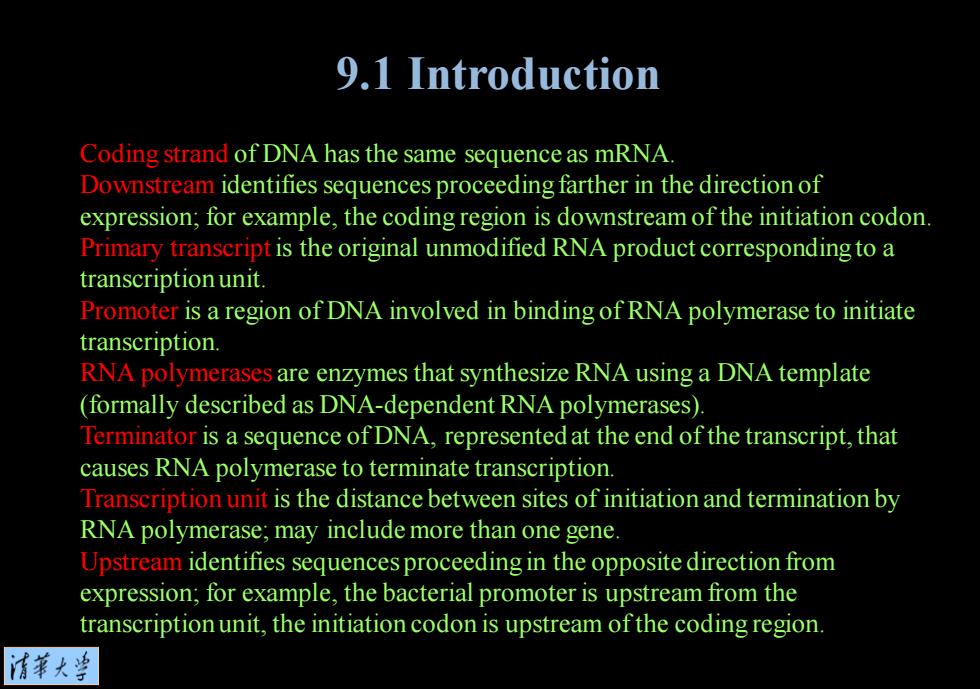
9.1 Introduction Coding strand of DNA has the same sequence as mRNA. Downstream identifies sequences proceeding farther in the direction of expression;for example,the coding region is downstream of the initiation codon. Primary transcript is the original unmodified RNA product corresponding to a transcription unit. Promoter is a region of DNA involved in binding of RNA polymerase to initiate transcription. RNA polymerases are enzymes that synthesize RNA using a DNA template (formally described as DNA-dependent RNA polymerases). Terminator is a sequence of DNA,represented at the end of the transcript,that causes RNA polymerase to terminate transcription. Transeription unit is the distance between sites of initiation and termination by RNA polymerase;may include more than one gene. Upstream identifies sequences proceeding in the opposite direction from expression;for example,the bacterial promoter is upstream from the transcription unit,the initiation codon is upstream of the coding region. 清菜大兰
Coding strand of DNA has the same sequence as mRNA. Downstream identifies sequences proceeding farther in the direction of expression; for example, the coding region is downstream of the initiation codon. Primary transcript is the original unmodified RNA product corresponding to a transcription unit. Promoter is a region of DNA involved in binding of RNA polymerase to initiate transcription. RNA polymerases are enzymes that synthesize RNA using a DNA template (formally described as DNA-dependent RNA polymerases). Terminator is a sequence of DNA, represented at the end of the transcript, that causes RNA polymerase to terminate transcription. Transcription unit is the distance between sites of initiation and termination by RNA polymerase; may include more than one gene. Upstream identifies sequences proceeding in the opposite direction from expression; for example, the bacterial promoter is upstream from the transcription unit, the initiation codon is upstream of the coding region. 9.1 Introduction
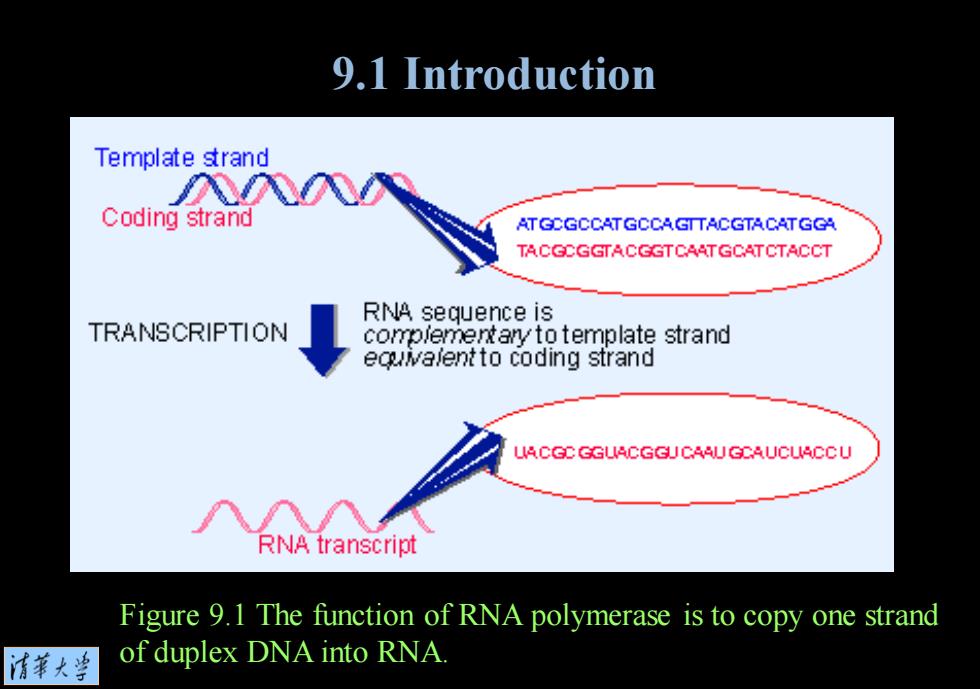
9.1 Introduction Template strand 入入0 Coding strand ATGCGCCATGCCAGTTACGTACATGGA TACGCGGTACGGTCAATGCATCTACCT RNA sequence is TRANSCRIPTION comp/emertary to template strand equva/entto coding strand LACGC GGUACGGUCAAUGCAUCUACCU RNA transcript Figure 9.1 The function of RNA polymerase is to copy one strand 情莱大当 of duplex DNA into RNA
Figure 9.1 The function of RNA polymerase is to copy one strand of duplex DNA into RNA. 9.1 Introduction
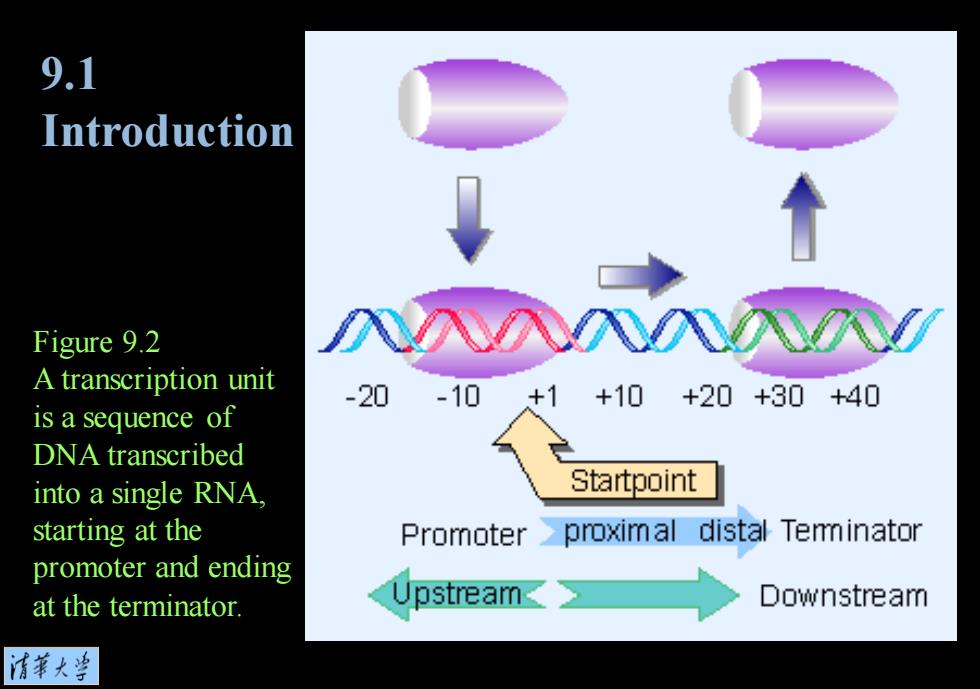
9.1 Introduction Figure 9.2 A transcription unit -20 -10 +1 +10+20+30+40 is a sequence of DNA transcribed into a single RNA, Startpoint starting at the Promoter proximal distal Teminator promoter and ending at the terminator. Downstream 清第大当
Figure 9.2 A transcription unit is a sequence of DNA transcribed into a single RNA, starting at the promoter and ending at the terminator. 9.1 Introduction
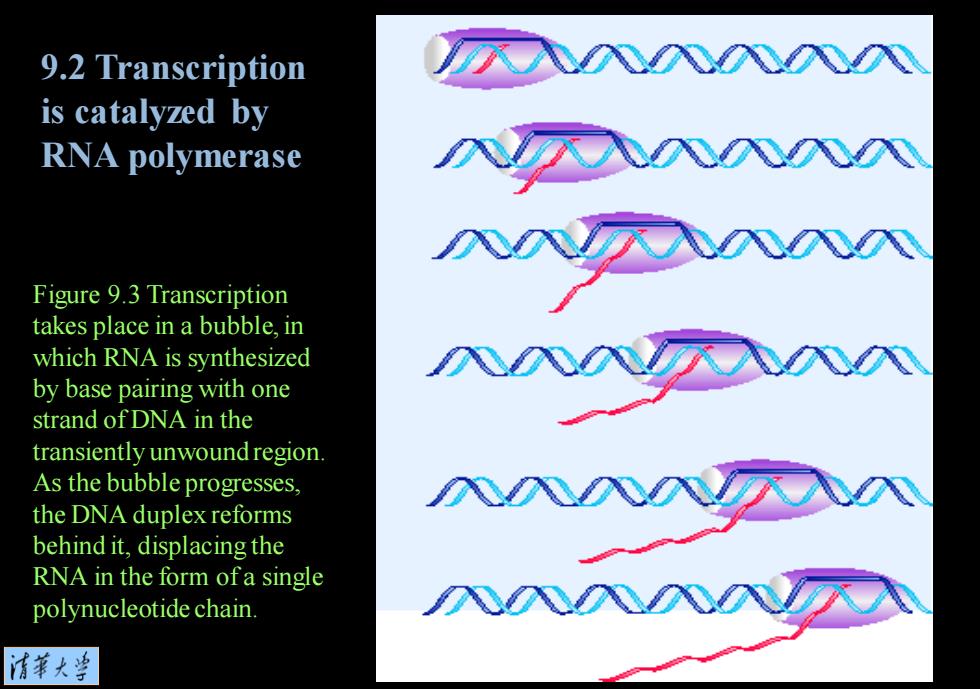
9.2 Transcription is catalyzed by RNA polymerase Figure 9.3 Transcription takes place in a bubble,in which RNA is synthesized by base pairing with one strand of DNA in the transiently unwound region. As the bubble progresses, the DNA duplex reforms behind it,displacing the RNA in the form of a single polynucleotide chain. 清菜大当
Figure 9.3 Transcription takes place in a bubble, in which RNA is synthesized by base pairing with one strand of DNA in the transiently unwound region. As the bubble progresses, the DNA duplex reforms behind it, displacing the RNA in the form of a single polynucleotide chain. 9.2 Transcription is catalyzed by RNA polymerase
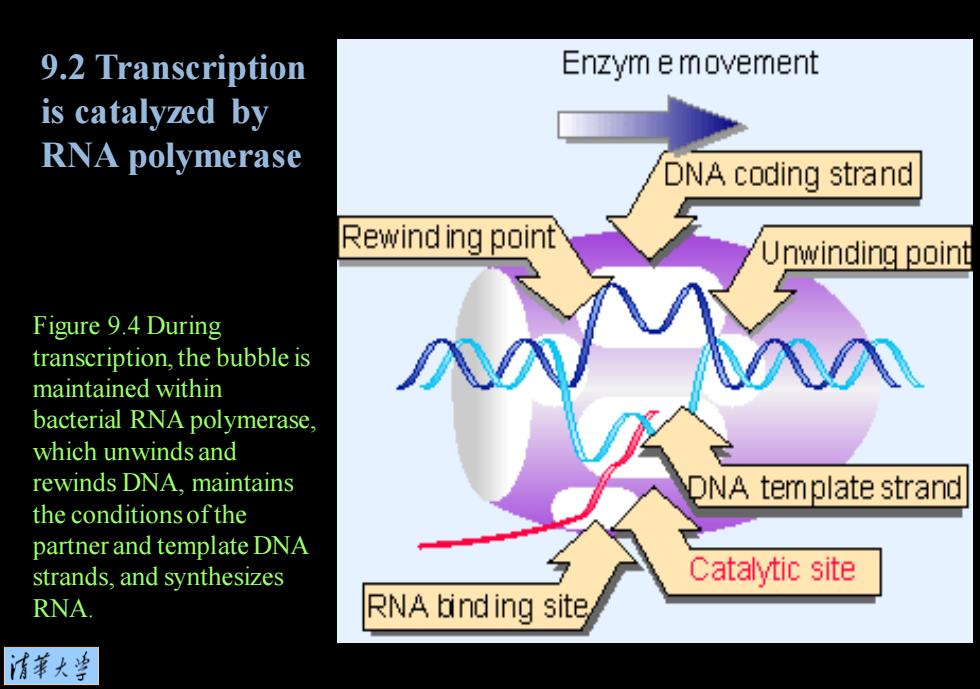
9.2 Transcription Enzym e movement is catalyzed by RNA polymerase DNA coding strand Rewind ing point Unwinding point Figure 9.4 During transcription,the bubble is maintained within bacterial RNA polymerase, which unwinds and rewinds DNA,maintains ONA template strand the conditions of the partner and template DNA strands,and synthesizes Catalytic site RNA. RNA bind ing site 清菜大当
Figure 9.4 During transcription, the bubble is maintained within bacterial RNA polymerase, which unwinds and rewinds DNA, maintains the conditions of the partner and template DNA strands, and synthesizes RNA. 9.2 Transcription is catalyzed by RNA polymerase
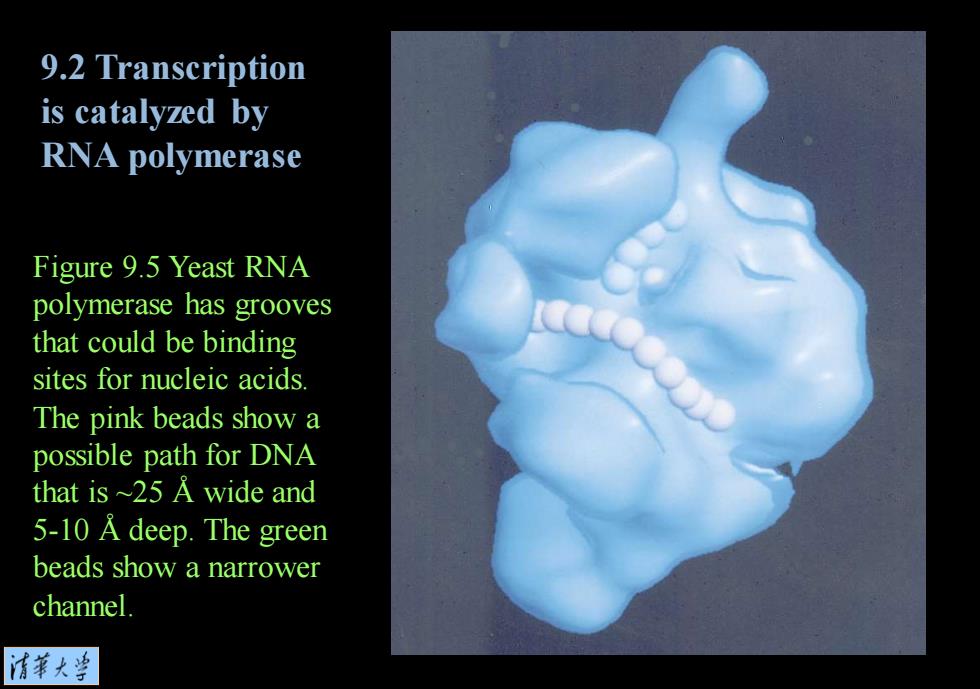
9.2 Transcription is catalyzed by RNA polymerase Figure 9.5 Yeast RNA polymerase has grooves that could be binding sites for nucleic acids. The pink beads show a possible path for DNA that is ~25 A wide and 5-10 A deep.The green beads show a narrower channel. 清菜大当
Figure 9.5 Yeast RNA polymerase has grooves that could be binding sites for nucleic acids. The pink beads show a possible path for DNA that is ~25 Å wide and 5-10 Å deep. The green beads show a narrower channel. 9.2 Transcription is catalyzed by RNA polymerase

5 end of 5'nucleotide 9.2 Transcription triphosphate being added to chain is catalyzed by 0P,0 RNA polymerase Figure 9.6 Phosphodiester bond formation involves a hydrophilic attack by the 0=P0 3'-OH group of the last nucleotide of the chain on OH the 5'triphosphate of the Pyrophosphate is released incoming nucleotide,with release of pyrophosphate 清苇大兰
Figure 9.6 Phosphodiester bond formation involves a hydrophilic attack by the 3’-OH group of the last nucleotide of the chain on the 5’ triphosphate of the incoming nucleotide, with release of pyrophosphate. 9.2 Transcription is catalyzed by RNA polymerase
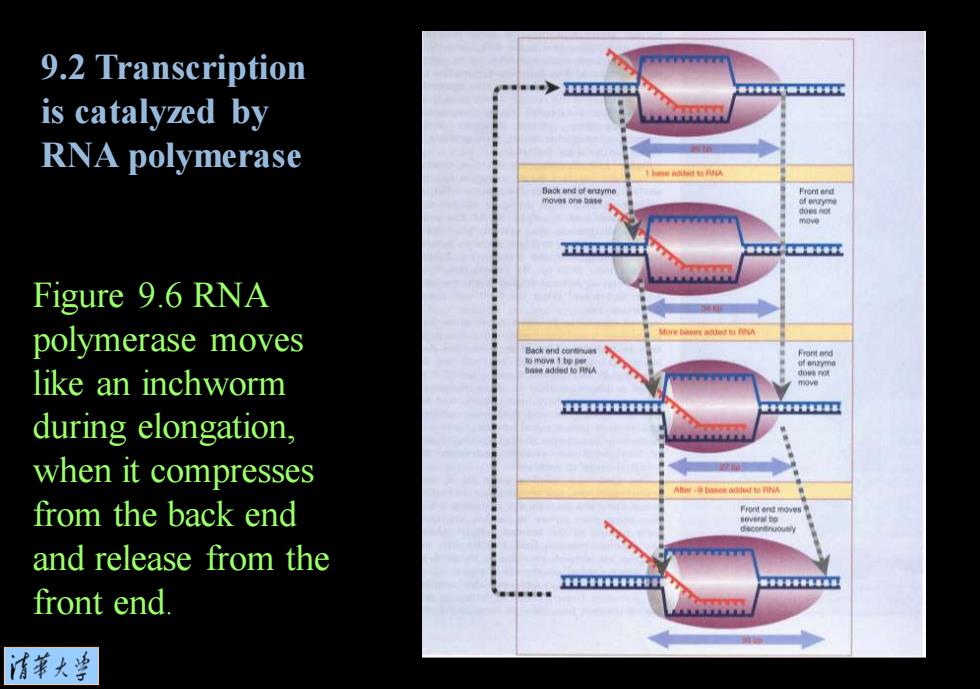
9.2 Transcription 工 is catalyzed by RNA polymerase Badk and ef enzyme 进进进进进进进 Figure 9.6 RNA polymerase moves like an inchworm during elongation, when it compresses from the back end and release from the front end 清菜大当
Figure 9.6 RNA polymerase moves like an inchworm during elongation, when it compresses from the back end and release from the front end. 9.2 Transcription is catalyzed by RNA polymerase